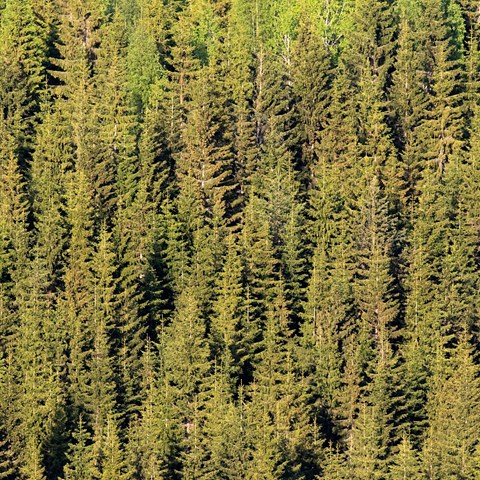Contact

Per-Erik Wikberg, Analyst
Department of Forest Resource Management / The Swedish National Forest Inventory / SHa, SLU
Per-Erik.Wikberg@slu.se, +46(0)90-786 8303

Productive forest land is land that is suitable for forestry and that is not significantly used for other purposes. Production is at least 1 m³sk per hectare and year. There are cirka 23.5 million hectares of productive forest land in Sweden, equivalent to 58% of the land area. Data presented here are all productive forest land including or outside formally protected areas.
Evergreens dominant - but broadleaves are increasing
As for all forest land in Sweden, productive forest land is dominated by evergreen forests (82%) with scots pine the most common stand type (40 %). Worth noting is that the exotic species Lodgepole pine accounts for 2% of the productive forest land area, and this proportion in southern Norrland is almost 4%. Since the midddle of the 1980's the area of broadleaved dominated forest has increased in all regions except northern Norrland. Since 1985 and seen for the whole country the area of broadleaved dominated forest has increased from 6 to 9%.
Thinning stage forest is the most common
Maturity class is a classification of the forest from a forestry perspective. The dominant maturity class in productive forest land in Sweden is thinning stage forest (40%) and cirka 32% has reach the minium age for final felling. Approximately 6% of the productive forest area is thicket stage of which ca 79% is artificially regenerated and the rest naturally regenerated forest.
Increased standing volume
The standing volume of productive forest land has increased steadily since the beginning of the 1900's and is currently cirka 3347 miljoner m³sk. This is an increase of 98% since the beginning of the 1920's. Behind this development is primarily a production and growth orientated forest management.
Since 1990 the standing volume of broadleaves has increased by appr. 60% and currently represents 19% of the total standing volume.
The steadily increasing standing volume is occcured despite the fact that the area of productive forest land has remained relatively unchanged and this has meant that the forests have become more dense. Standing volume per hectare is currently 143 m³sk per hectare and 141 m³sk outside formally protected areas.
Significant increase in hard dead wood
Since the Swedish National Forest Inventory started collected data on all types of dead wood in the mid 1990's the total volume of dead wood has increased in all region except northern Norrland. This increase is dominated by hard dead wood. The total volume of dead wood on productive forest land is 252 million m³ or 10.8 m³ per hectare
Growth and drain
Similar to standing volume, growth has increased steadily in Sweden's forests. However during the latest years the growth har reduced and is now 114 million m³sk and the natural mortality on an all time high of 17.5 million m³sk annually on all productive forest land.
Forest damage
The Swedish National Forest Inventory registers damage to trees which could affect timber production or quaility. The highest level of forest damage is found in spruce stands in southern Sweden (10%) and in pine stands in northern Sweden (15%). The most common type of damage in evergreens is mechanical damage from wind and snow or grazing.
Damage from Moose grazing
The proportion of young pine trees with fresh moose grazing damage has, since 2003, been between 6-26%. This level is clearly over the forestry sectors goal: 2% on low productivity sites and 5% on other sites. Between 2008 and 2013 moose grazing damage has showed an increasing trend in all parts of the country but after that a decreasing trend can be seen in Svealand and Götaland.
Mean annual natural loss by tree species ![]()
Mean annual volume increment per hectare by age classes
SLU has been appointed by the Swedish government as responsible for the official statistics about the state and change of Swedens forests. Read more about SLU's official statistics. The Swedish Forest Agency is the responsible authority for felling statistics produced by SLU. As an authority responsible for official statistics SLU must make sure that:
Official statistics must be made available without cost and also be accessable in electronic form.
All official statistics must be clearly marked maked with Offiicial Statistics of Sweden or bear the following logotype:![]()
JO0801 - Skogsdata - current statistics about the Swedish forests
JO0802 - Area conditions
JO0803 - Standing volume and tree biomass
JO0804 - Annual volume increment
JO0805 - Vegetation and site conditions
JO0806 - Forest damage
Current publication dates are shown in Statistics Sweden's publication calender.

Per-Erik Wikberg, Analyst
Department of Forest Resource Management / The Swedish National Forest Inventory / SHa, SLU
Per-Erik.Wikberg@slu.se, +46(0)90-786 8303